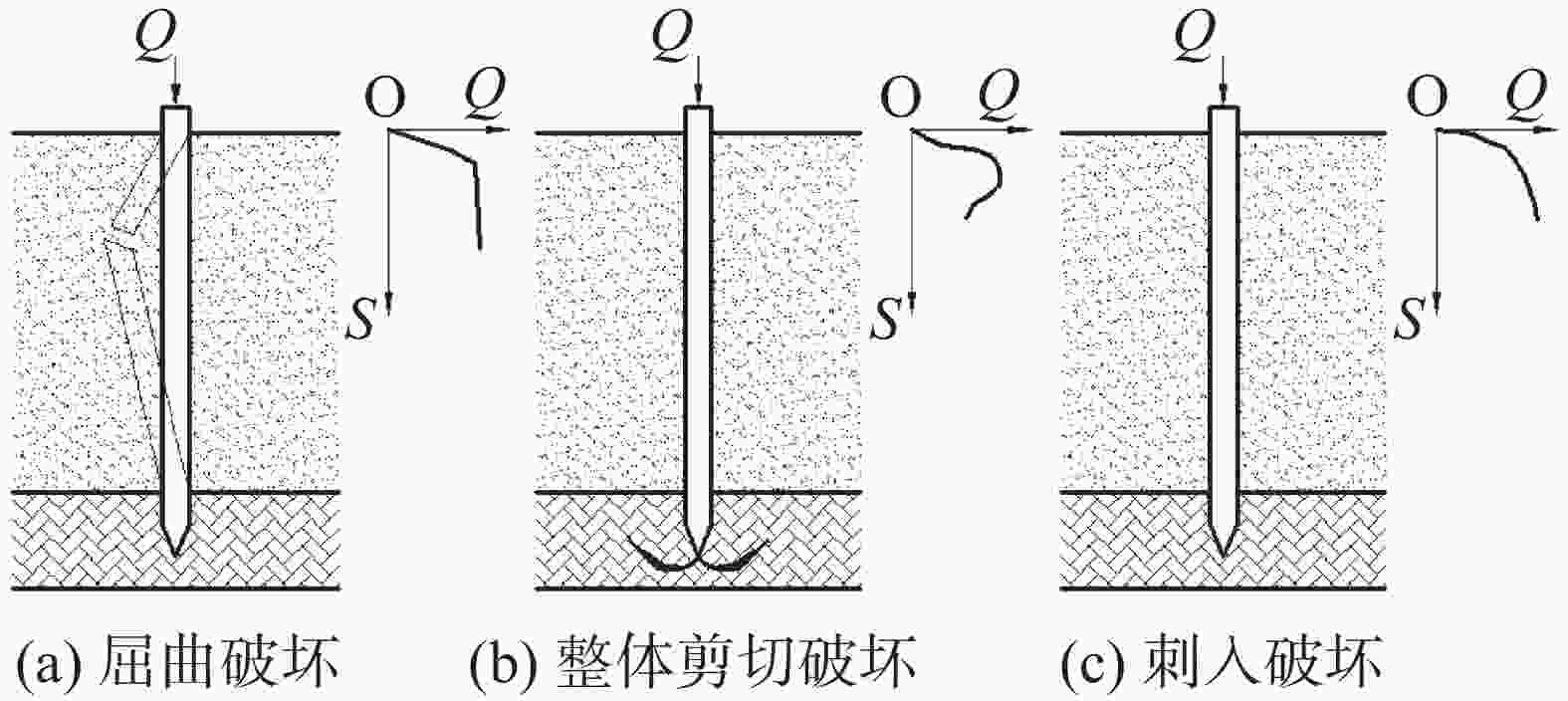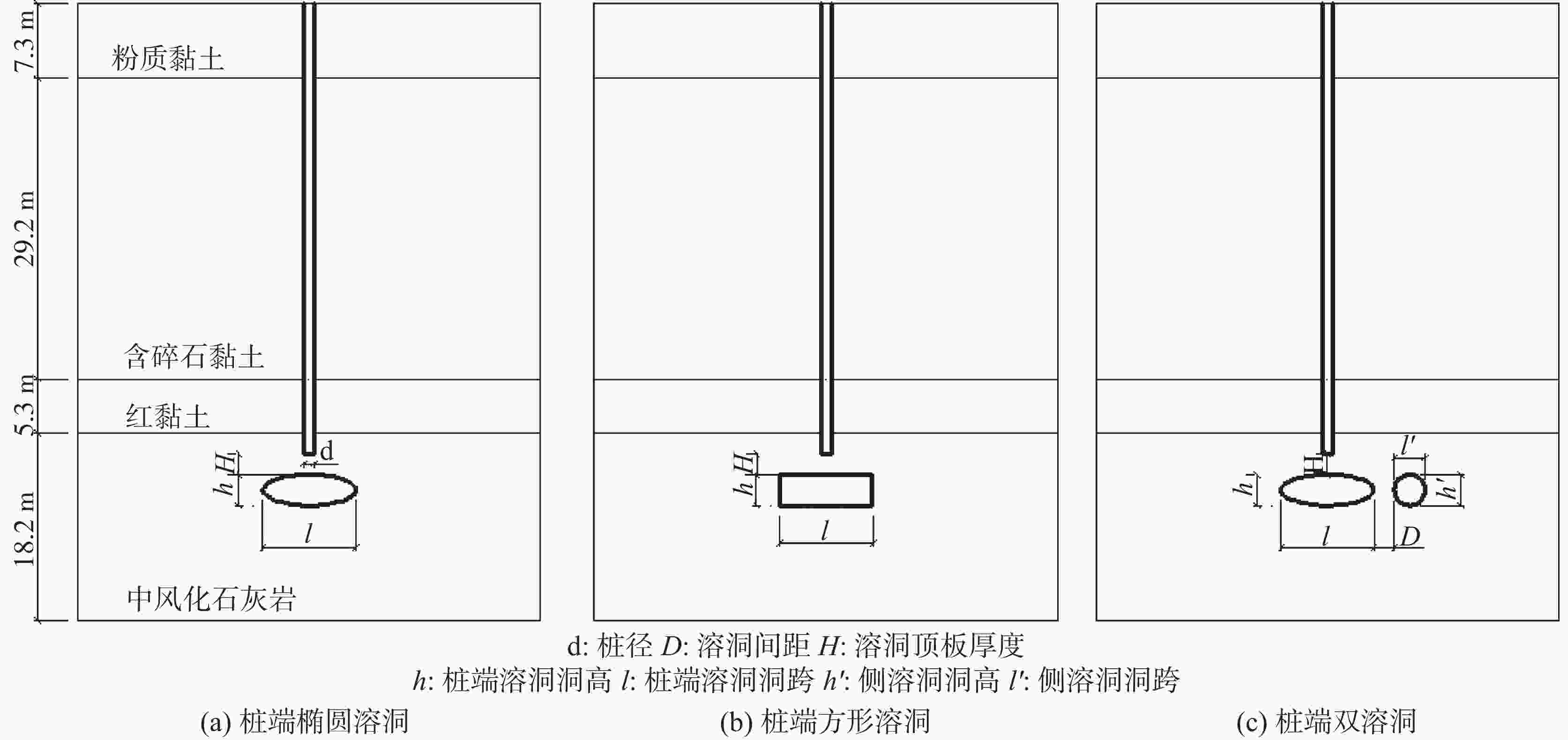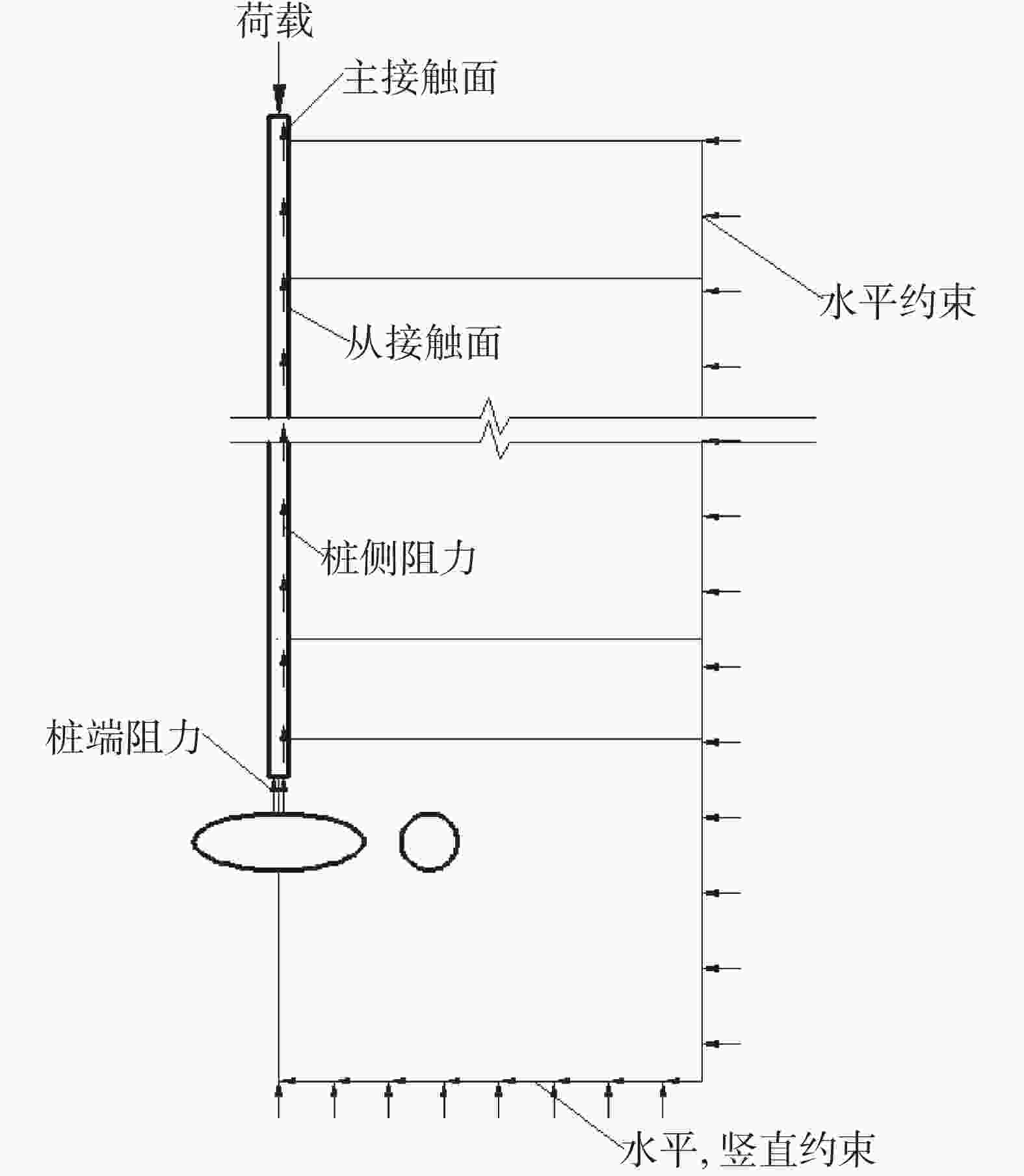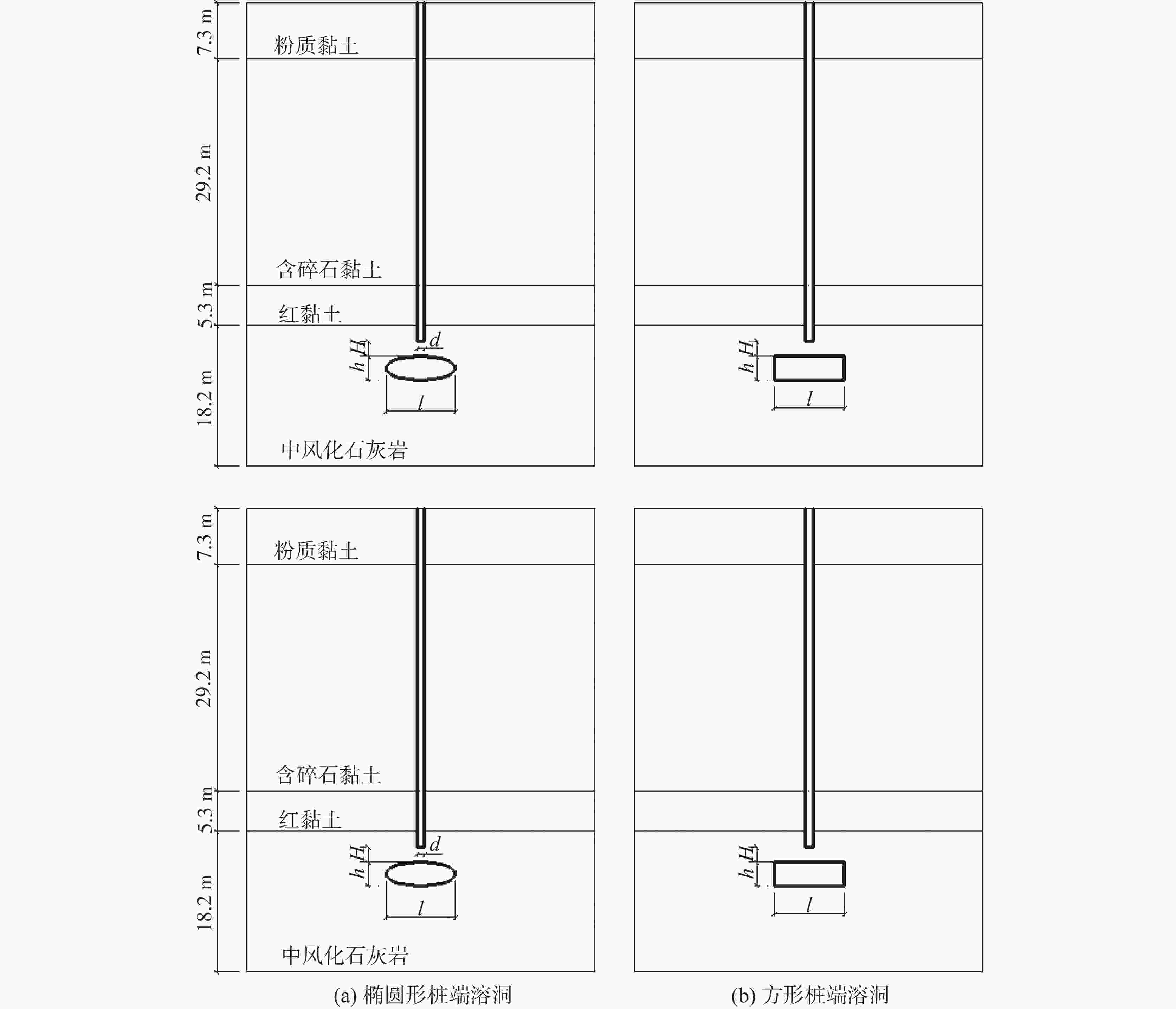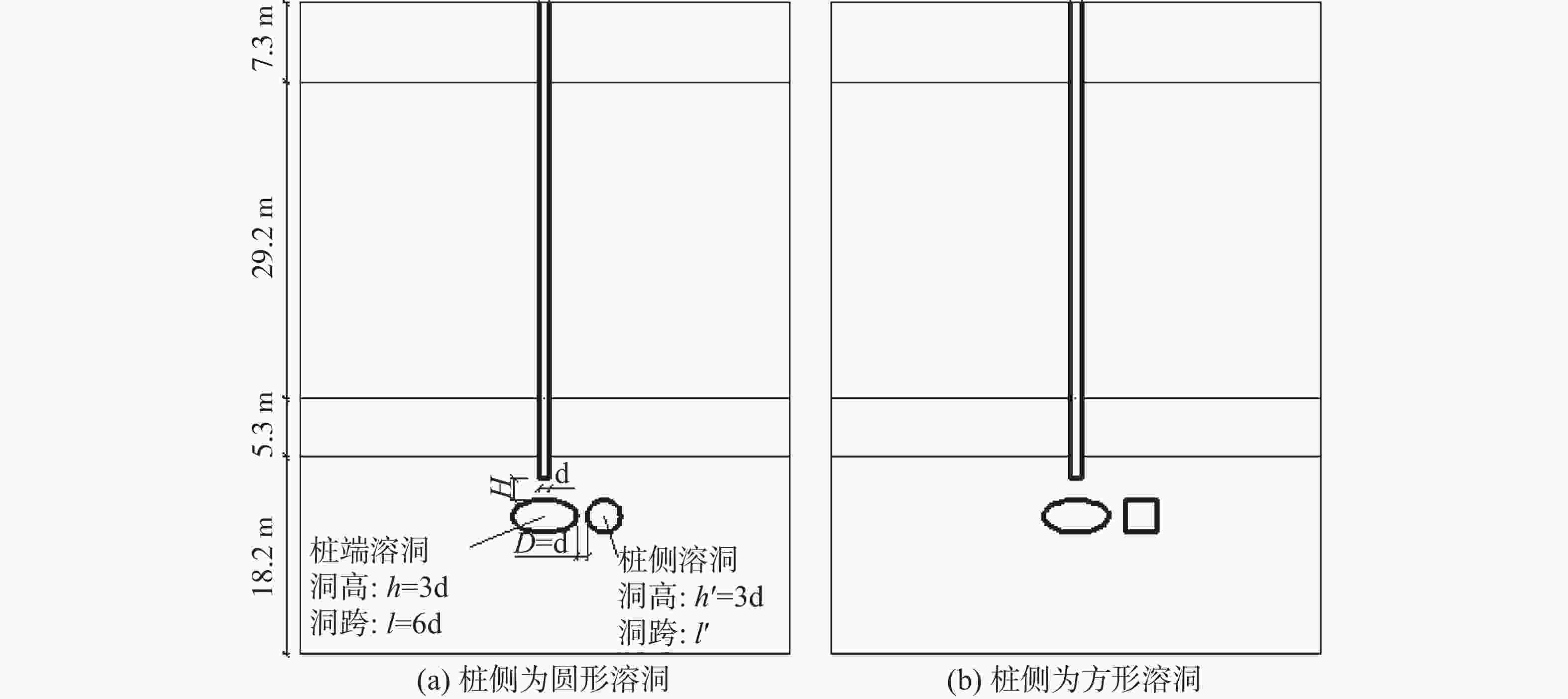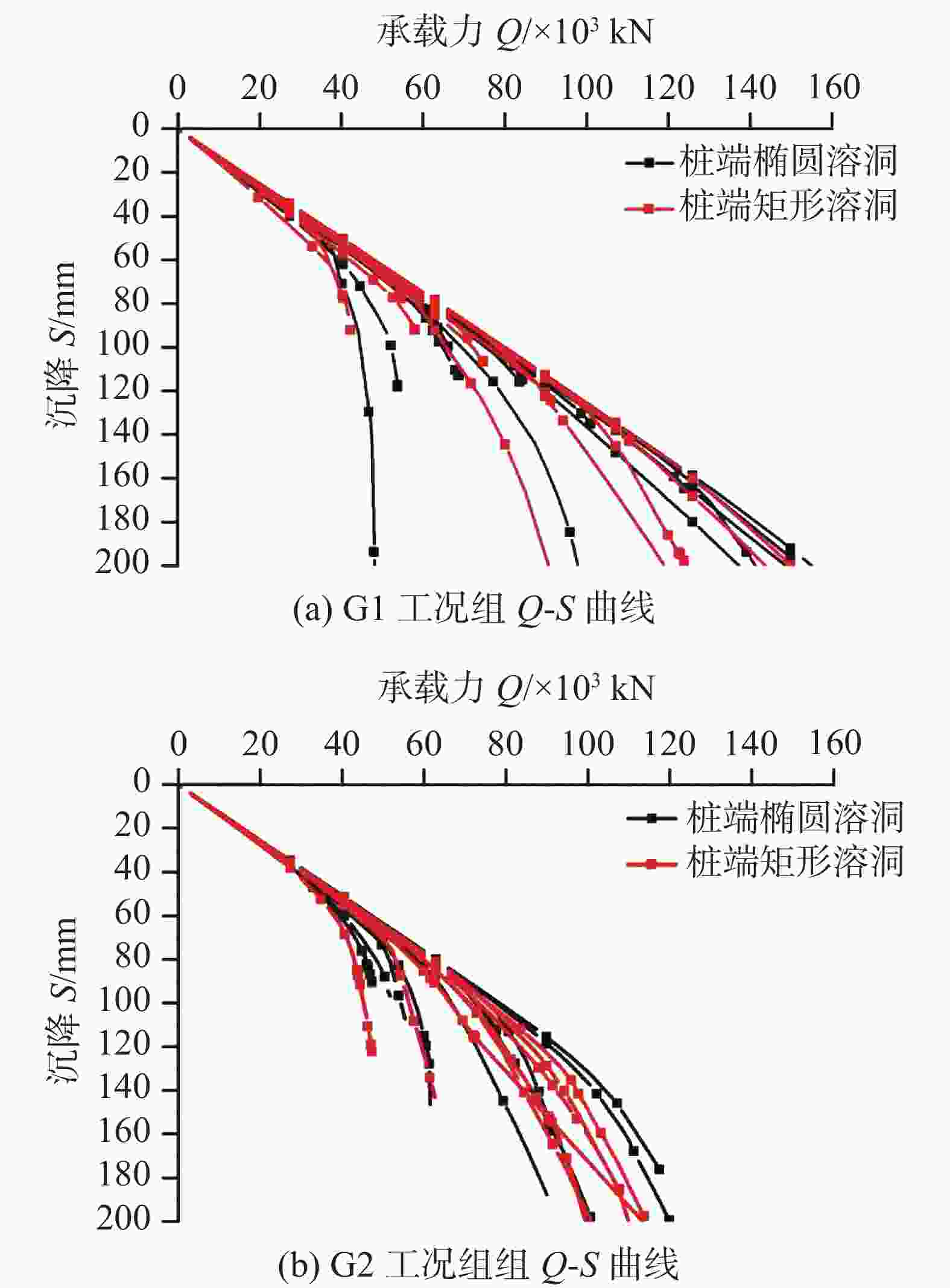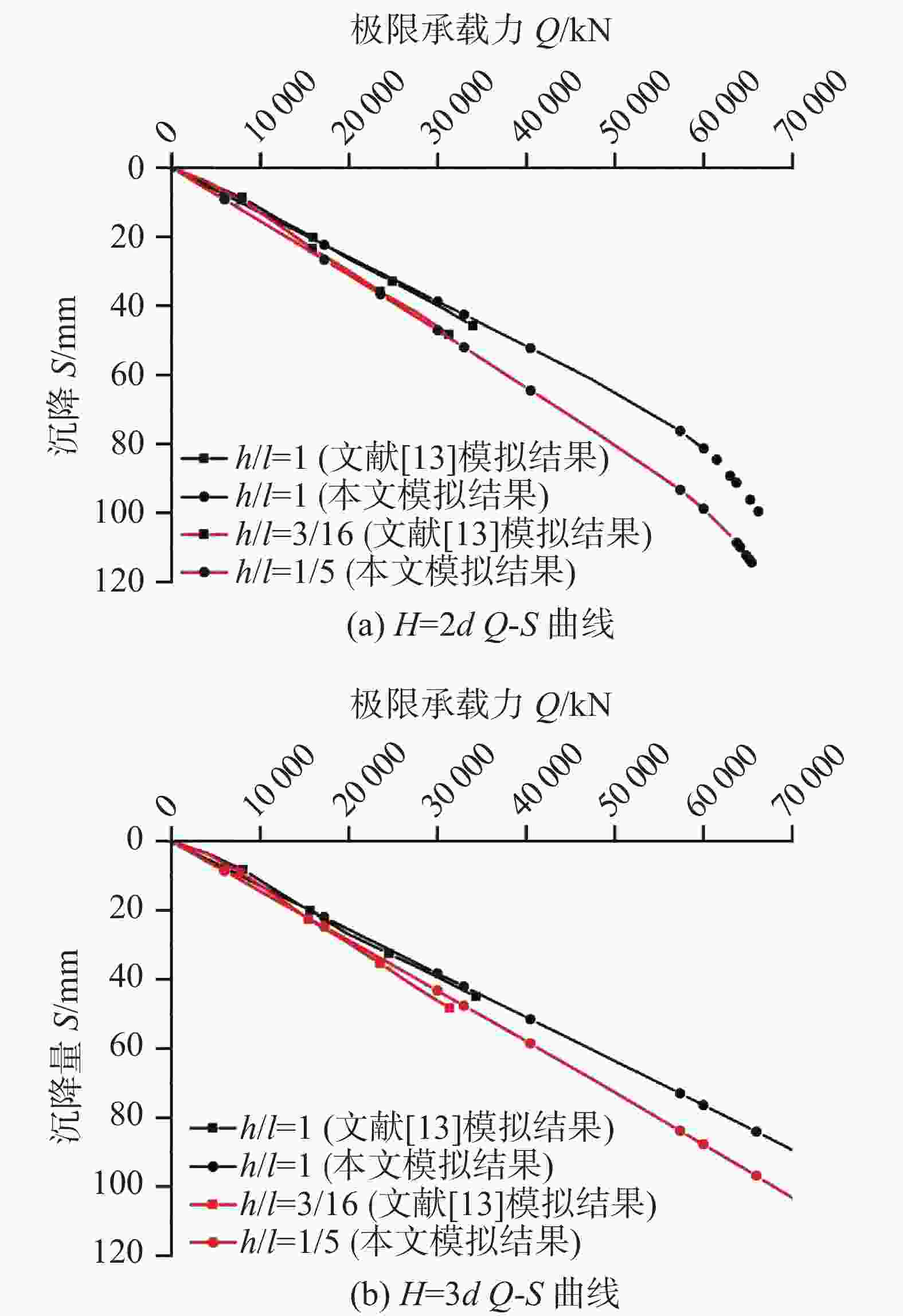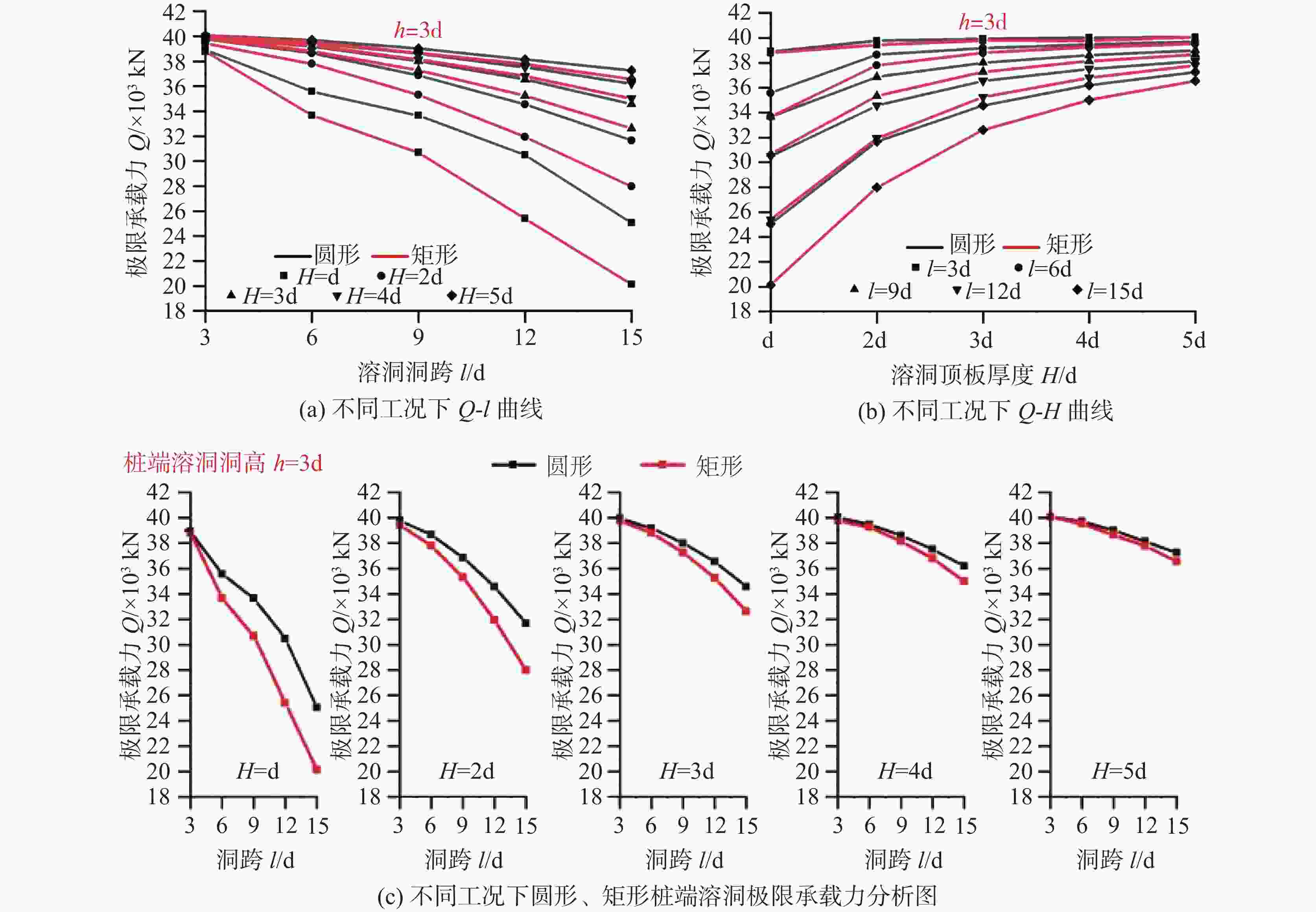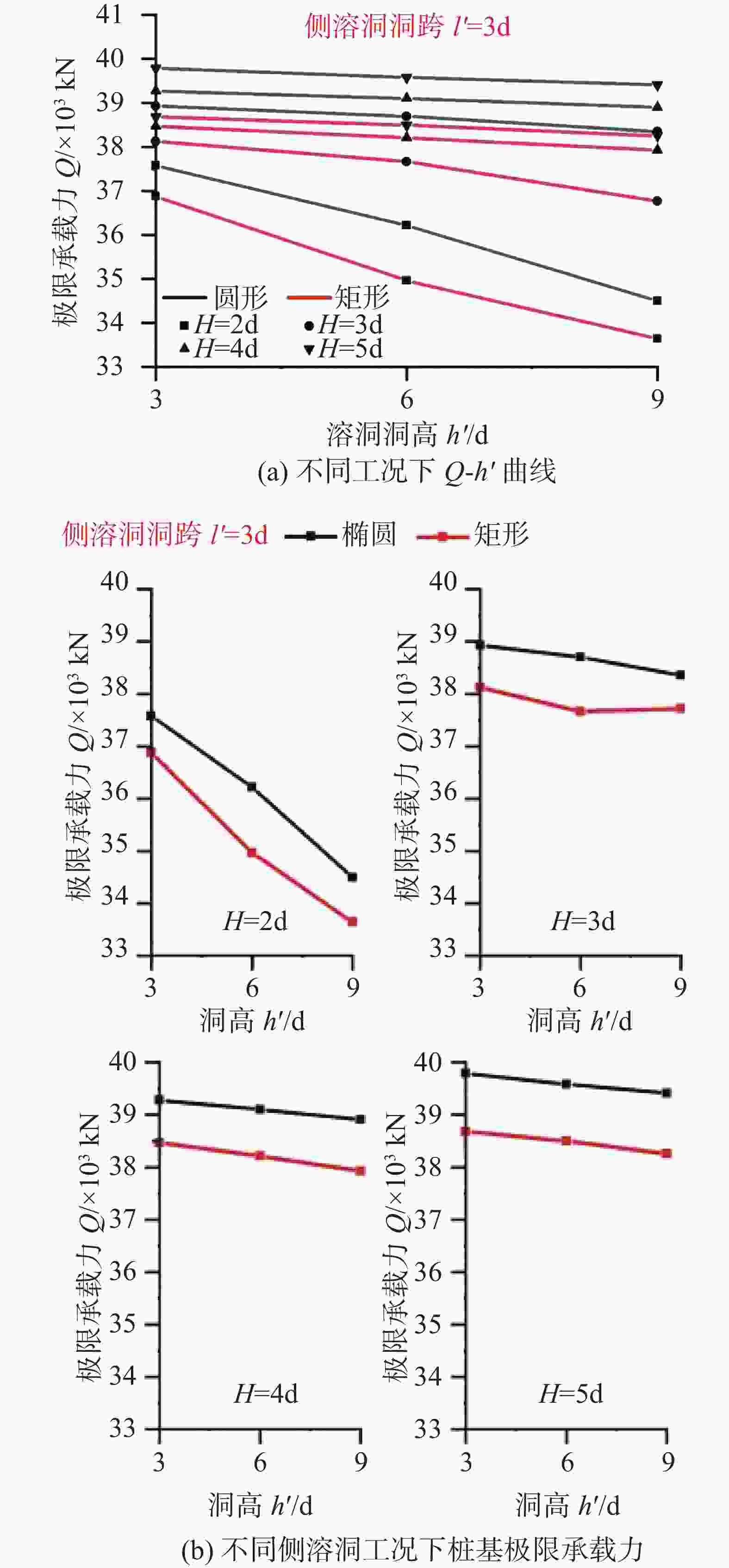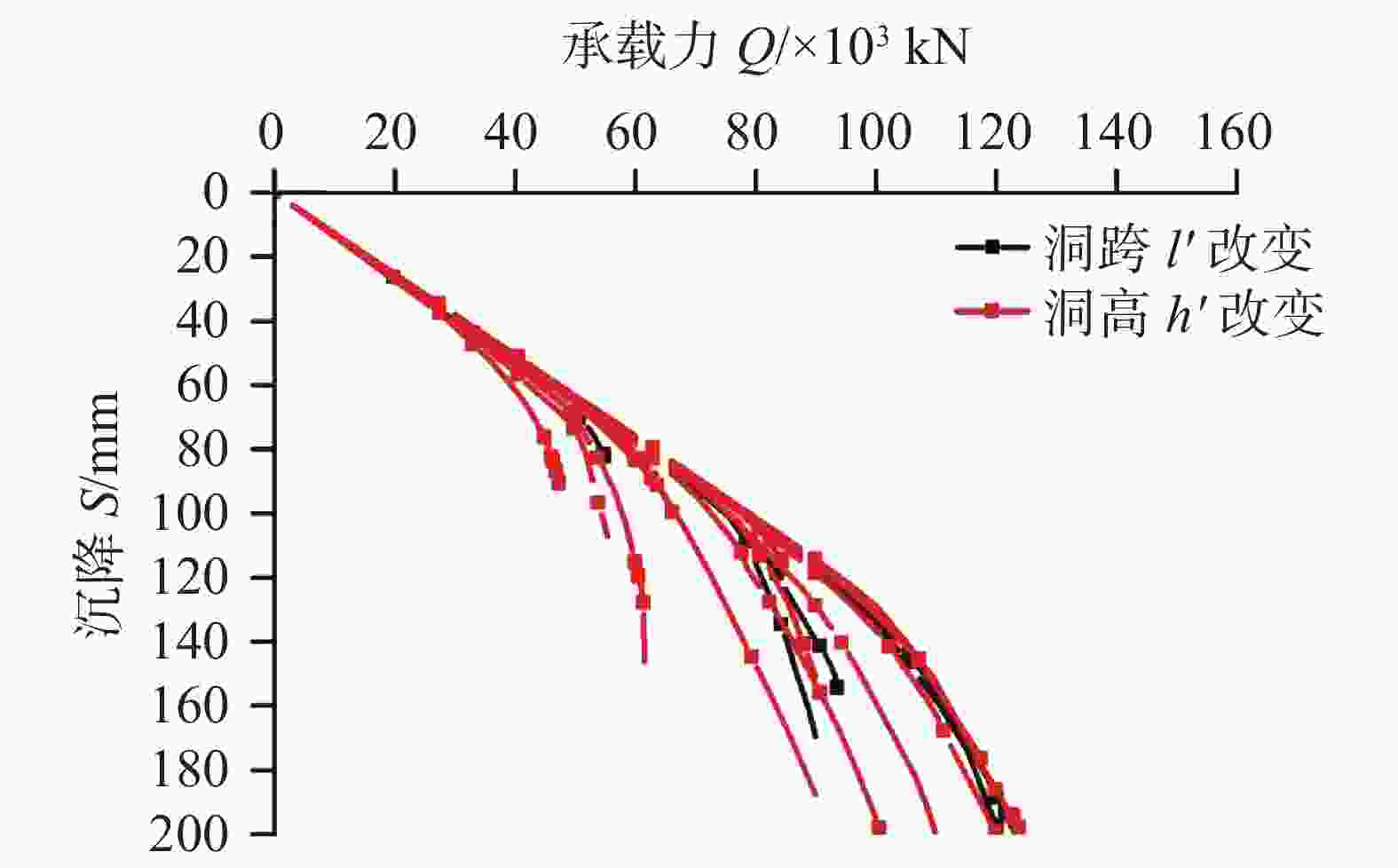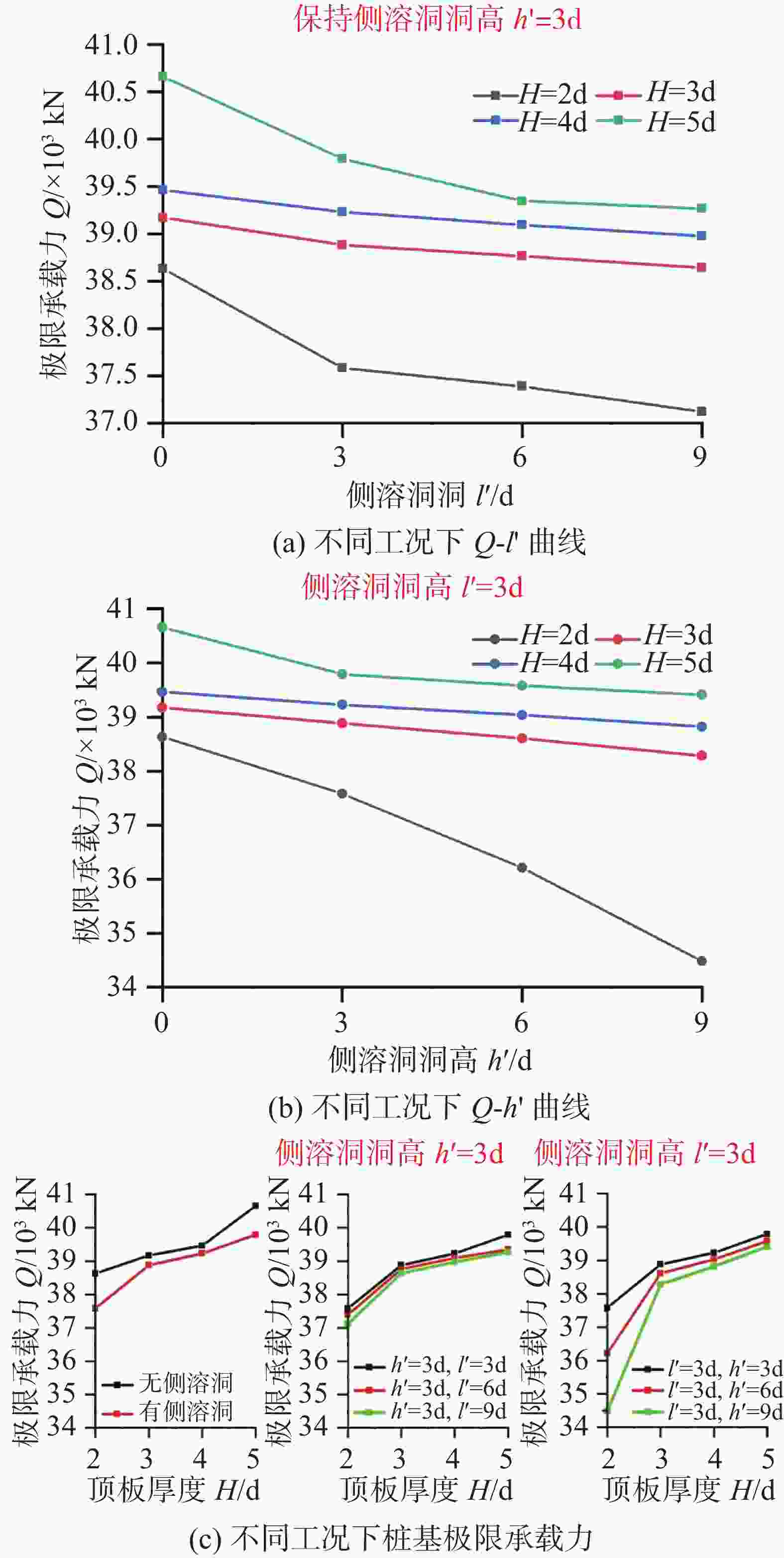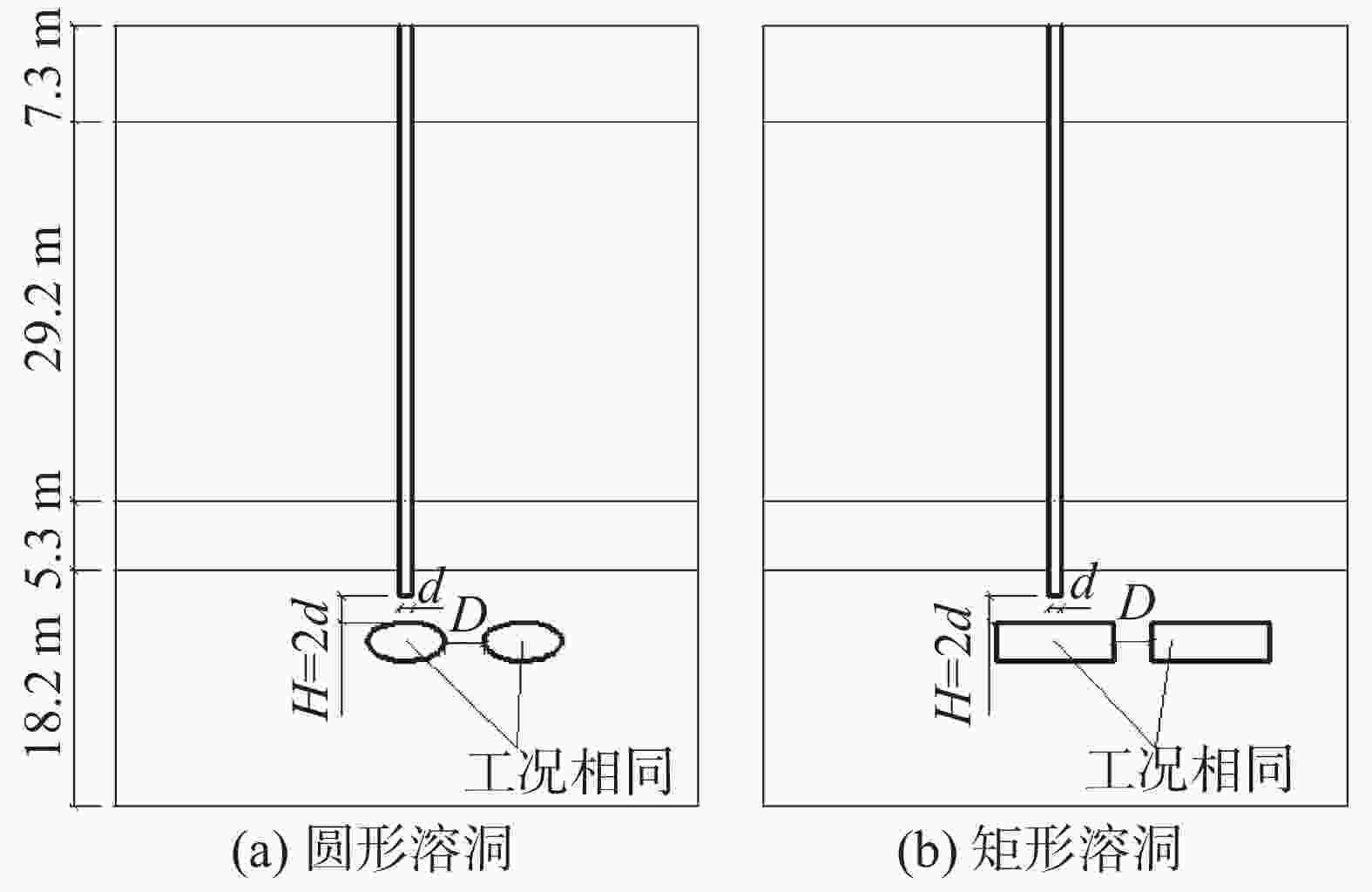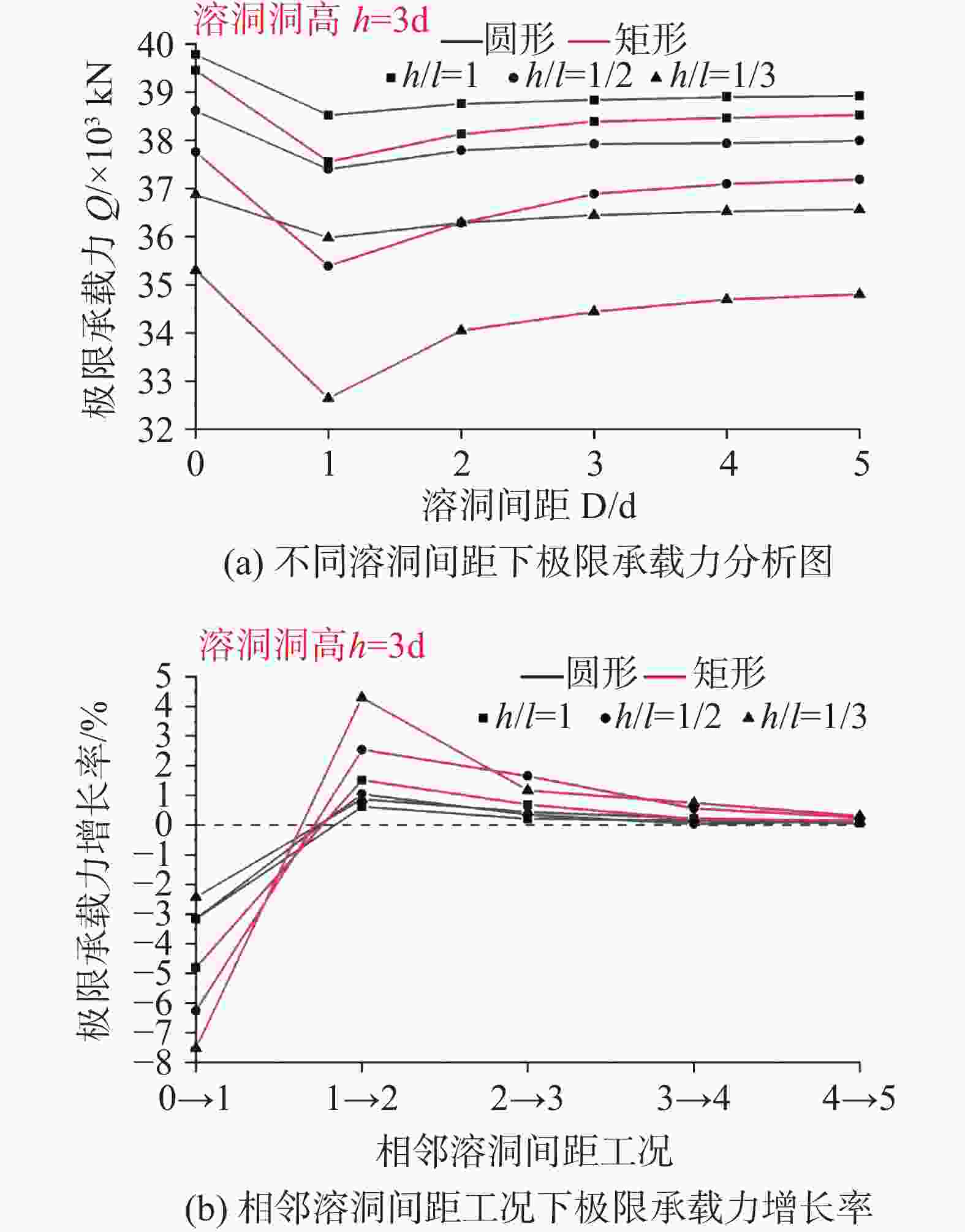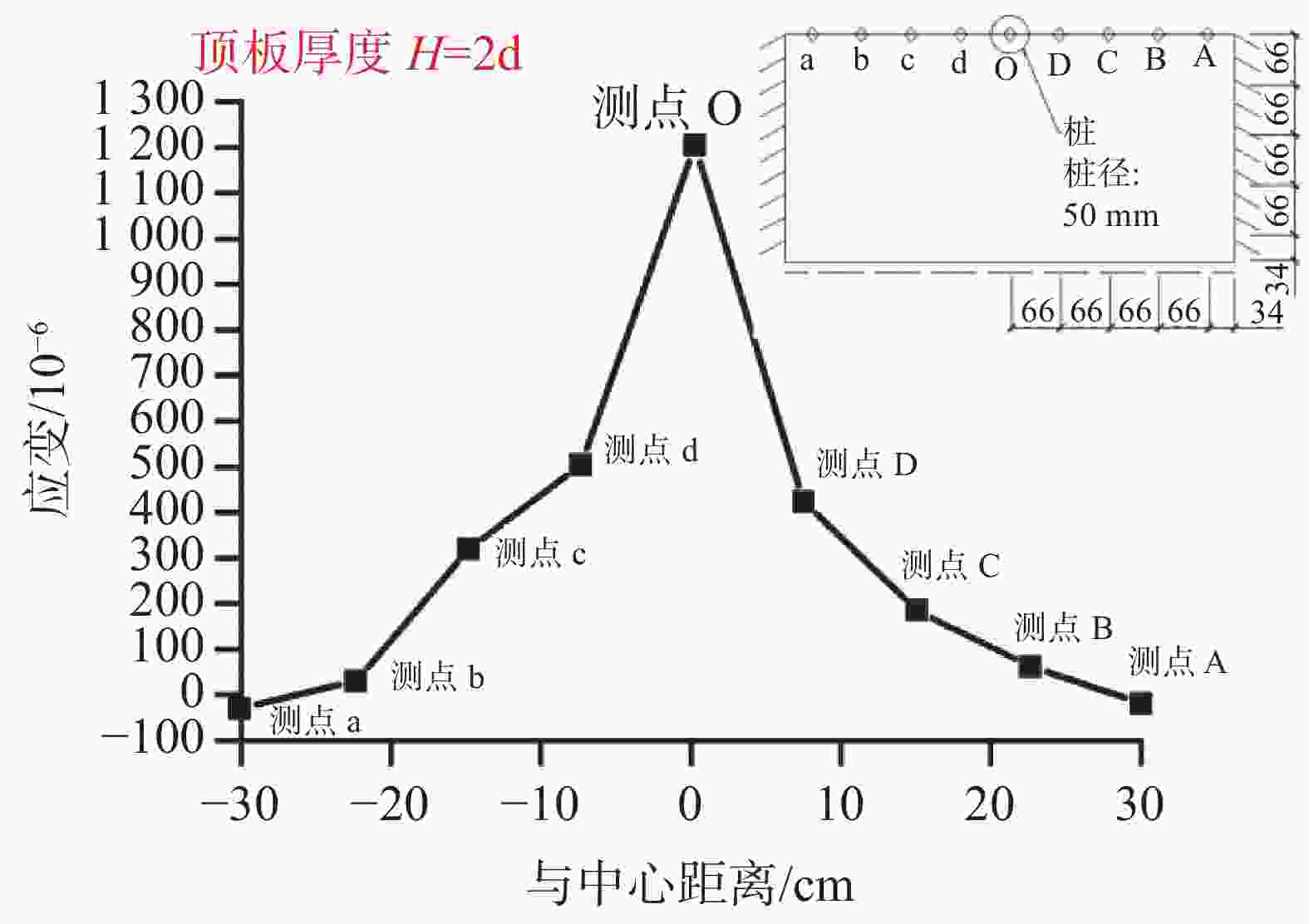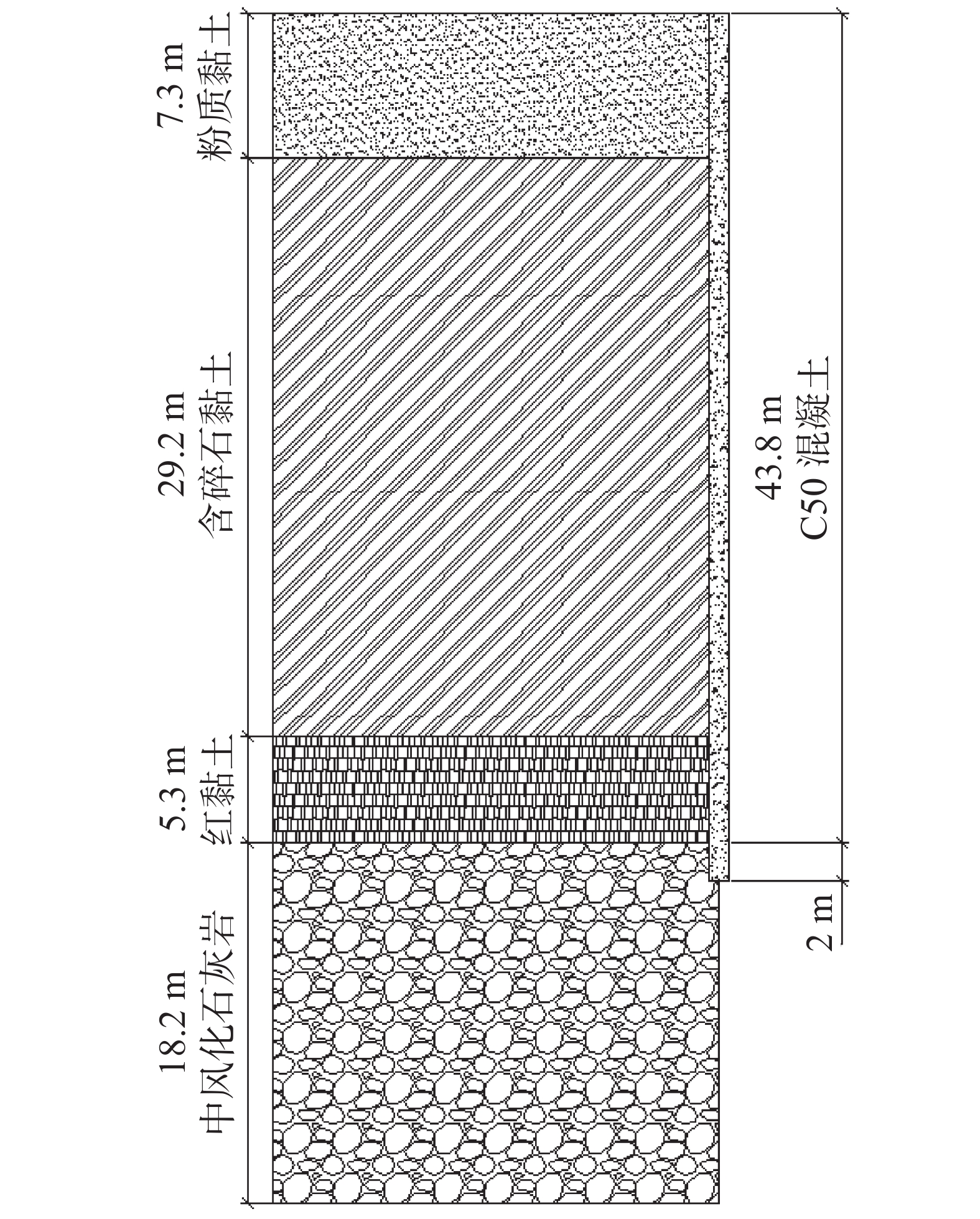Influence of multiple karst caves at the pile end on the bearing capacity of pile foundations based on ABAQUS
-
摘要: 岩溶区地基中往往含有多个溶洞,当前对含多溶洞桩基-地基承载机理的研究落后于工程实践。因此,针对含多溶洞地基-桩基承载机理,依托某岩溶桩基工程,应用大型有限元分析软件ABAQUS建立模型,通过对桩基荷载-位移曲线的分析,探讨不同溶洞顶板厚度下溶洞形状、溶洞几何特性及溶洞间距对桩基极限承载力的影响。结果表明:相同工况下,方形溶洞对桩基承载力的不利影响大于圆形溶洞;随着溶洞单一尺寸的增大,溶洞对桩基极限承载力的不利影响逐渐增大。桩端存在双溶洞时,侧溶洞洞高对桩基极限承载力的影响大于洞跨对其的影响;随着溶洞间距的增大,侧溶洞对桩基承载力的影响降低,当间距达到5倍桩径时,侧溶洞对桩基承载力的影响可忽略。Abstract:
As an important load-bearing structure of buildings, the stability of pile foundations will directly impact building safety. With the expansion of engineering construction, foundations are frequently laid in an encounter with multiple karst caves. However, research on the influence of complex geological conditions with multiple karst caves at the pile end on the ultimate bearing capacity of pile foundations lags behind engineering practice. Therefore, studying this impact is crucial for engineering practice. In this study, a model of pile end containing multiple karst caves was established by the large finite element analysis software ABAQUS, with reference to a specific karst pile foundation project in the Hongshan district, Wuhan City, Hubei Province. This study aimed to explore the influence of cave shape, geometric characteristics, and spacing between karst caves on the ultimate bearing capacity of pile foundations under complex geological conditions with multiple karst caves at the pile end. This study involved the following steps. 1. Geological models of piles and karst caves were established. This involved firstly determining the premise assumptions for finite element analysis, selecting appropriate constitutive models, setting relevant parameters of pile foundations and engineering geological conditions based on a specific karst pile foundation project; secondly, setting constraints and boundary conditions, performing grid division, and determining calculation analysis; finally, establishing the model of comparative working condition groups according to the research purpose. 2. The finite element analysis was conducted with ABAQUS to simulate the displacement process of pile foundations under various karst geological conditions subjected to external forces. 3. Data compilation and analysis were completed. Load-displacement curves of pile foundations under different karst geological conditions were compiled. Based on Technical Code for Testing of Building Foundation Piles and the failure mode of pile foundations in simulation, the standard for selecting the ultimate bearing capacity of pile foundations was determined. Ultimate bearing capacities of pile foundations under different working conditions were extracted, organized, and graphed to analyze the influence of different cave parameters on the ultimate bearing capacity of pile foundations. The results indicate that under the same conditions of a single karst cave, square caves exert a greater adverse impact on the ultimate bearing capacity of pile foundations than circular ones. However, when the cave cap thickness reaches 5 times the pile diameter, the impact of cave shape on the pile foundation becomes negligible. As the single-direction size of the karst caves increases, their adverse effect on the ultimate bearing capacity of the pile foundation gradually intensifies. If two karst caves are present at the pile end with centroids at the same elevation, the appearance of a side cave will significantly reduce the ultimate bearing capacity of the pile foundation. The ultimate bearing capacity of the pile foundation when both caves are elliptical is greater than when they are rectangular. If a constant change of single-directional size for the side cave maintains, when the thickness of the cave cap H is ≤3d, the change in cave height will exert a much greater impact on the ultimate bearing capacity of the pile foundation than the change in span; when H is equal to 5d, the influence of the change in the span of side cave on the ultimate bearing capacity of the pile foundation will exceed that of change in the cave height. As the cave spacing increases, the influence of side caves on ultimate bearing capacity gradually decreases; when the spacing reaches five times the pile diameter, this effect can be ignored. This study employs the numerical simulation method with ABAQUS to analyze the ultimate bearing capacity of pile foundations with multiple karst caves, delving deeper into the influence of geometric characteristics of side caves and cave spacing on the ultimate bearing capacity of pile foundations. It provides theoretical support and technical guidance for practical engineering. Additionally, it offers valuable references and insights for the design and construction of pile foundations under similar complex geological conditions. -
Key words:
- karst /
- pile foundation /
- ultimate bearing capacity /
- ABAQUS
-
表 1 桩和岩土体物理力学参数
Table 1. Mechanical parameters of pile and rock
岩土名称 层厚/m 密度ρ/kg·m−3 弹性模量E/MPa 泊松比µ 内聚c/kPa 内摩擦角 φ/° 粉质黏土 7.3 1 940 15 0.4 38 15 含碎石黏土 29.2 1 970 23 0.4 40 17 红黏土 5.3 1 960 27 0.4 35 12 中风化石灰岩 18.2 2 550 2e4 0.25 1e4 45 桩 43.8 2 500 3.55e5 0.2 表 2 G1、G2组模拟工况参数表
Table 2. Table of parameters for G1 and G2
溶洞数 分组 溶洞特征 顶板厚度H 桩端溶洞 桩侧溶洞 溶洞间距D 形状 洞高h 洞跨l 高跨比h/l 形状 洞高h' 洞跨l' 高跨比h'/l' 单 G1 d/2d/3d/4d/5d 矩形椭圆 3d 3d 1 / 6d 1/2 9d 1/3 12d 1/4 15d 1/5 双 G2 2d/3d/4d/5d 椭圆 3d 6d 1/2 矩形椭圆 3d 3d 1 d 6d 2 9d 3 表 3 G3组模拟工况参数表
Table 3. Parameters for G3
溶洞数 分组 溶洞特征 顶板
厚度
H桩端溶洞 桩侧溶洞 溶洞
间距
D形状 洞高h 洞跨l 高跨比h/l 形状 洞高h' 洞跨l' 高跨比h'/l' 双溶洞 G3 2d/3d/4d/5d 椭圆 3d 6d 1/2 椭圆 3d 3d 1 d 6d 1/2 9d 1/3 6d 3d 2 9d 3 表 4 G4组模拟工况参数表
Table 4. Parameters for G4
溶洞数 分组 溶洞特征 顶板
厚度
H桩端溶洞 桩侧溶洞 溶洞
间距
D形状 洞高h 洞跨l 高跨比h/l 形状 洞高h' 洞跨l' 高跨比h'/l' G4 2d 椭圆 3d 3d 1 椭圆 3d 3d 1 d
2d
3d
4d
5d6d 2 6d 2 9d 3 9d 3 矩形 3d 3d 1 矩形 3d 3d 1 6d 2 6d 2 9d 3 9d 3 -
[1] 刘自强, 马洪生, 牟云娟. 节理裂隙发育岩溶地基数值模拟稳定性分析[J]. 中国岩溶, 2022, 41(1):100-110.LIU Ziqiang, MA Hongsheng, MOU Yunjuan. Numerical simulation analysis and evaluation of stability of the karst foundation with developed joints and fissures[J]. Carsologica Sinica, 2022, 41(1): 100-110 [2] 肖鸿斌, 金耀岷. 深埋串珠状溶洞的超高层基础设计案例分析[J]. 中国岩溶, 2023, 42(2):382-390.XIAO Hongbin, JIN Yaomin. Case study on super high-rise foundation design of the deep-buried beaded karst cave[J]. Carsologica Sinica, 2023, 42(2): 382-390. [3] 吴迪, 李艾文, 李丹, 贾龙, 韦学英, 吴建建. 岩溶路基加筋防塌治理的简化设计方法[J]. 中国岩溶, 2023, 42(3):538-547.WU Di, LI Aiwen, LI Dan, JIA Long, WEI Xueying, WU Jianjian. Simplified design method of reinforcement treatment for karst subgrade collapse[J]. Carsologica Sinica, 2023, 42(3): 538-547. [4] 赵明华, 曹文贵, 何鹏祥, 杨明辉. 岩溶及采空区桥梁桩基桩端岩层安全厚度研究[J]. 岩土力学, 2004(1):64-68. doi: 10.3969/j.issn.1000-7598.2004.01.013ZHAO Minghua, CAO Wengui, HE Pengxiang, YANG Minghui. Study on safe thickness of rock mass at end of bridge foundation's pile in karst and worked-out mine area[J]. Rock and Soil Mechanics, 2004(1): 64-68. doi: 10.3969/j.issn.1000-7598.2004.01.013 [5] 赵明华, 张锐, 胡柏学, 袁铜森. 岩溶区桩端下伏溶洞顶板稳定性分析研究[J]. 公路交通科技, 2009, 26(9):13-16, 31.ZHAO Minghua, ZHANG Rui, HU Boxue, YUAN Tongsen. Analysis of stability of cave roof under pile tip in karst area[J]. Joural of Highway and Transportation Research and Development, 2009, 26(9): 13-16, 31. [6] 赵明华, 蒋冲, 曹文贵. 岩溶区嵌岩桩承载力及其下伏溶洞顶板安全厚度的研究[J]. 岩土工程学报, 2007, 29(11):1618-1622.ZHAO Minghua, JIANG Chong, CAO Wengui. Study on bearing capacity of rock-socked piles and safe thickness of cave roofs in karst region[J]. Chinese Journal of Geotechnical Engineering, 2007, 29(11): 1618-1622. [7] 蒋冲, 赵明华, 曹文贵, 刘小平. 基于模糊和突变理论的岩溶区桩端溶洞顶板稳定性分析方法研究[J]. 公路交通科技, 2008, 25(12):49-53, 64.JIANG Chong, ZHAO Minghua, CAO Wengui, LIU Xiaoping. Research on stability evaluation method for cave roof under pile tip in karst region based on fuzzy theory and catastrophe theory[J]. Joural of Highway and Transportation Research and Development, 2008, 25(12): 49-53, 64. [8] 张慧乐, 张智浩, 王述红, 孙映霞. 岩溶区嵌岩桩的试验研究与分析[J]. 土木工程学报, 2013, 46(1):92-103.ZHANG Huile, ZHANG Zhihao, WANG Shuhong, SUN Yingxia. Experimental study and analysis on rock-socketed pile in karst area[J]. China Civil Engineering Journal, 2013, 46(1): 92-103. [9] 张慧乐, 马凛, 张智浩, 孙映霞. 岩溶区嵌岩桩承载特性影响因素试验研究[J]. 岩土力学, 2013, 34(1):92-100.ZHANG Huile, MA Ling, ZHANG Zhihao, SUN Yingxia. Test research on factors influencing bearing capacity of rock-socketed piles in karst area[J]. Rock and Soil Mechanics, 2013, 34(1): 92-100. [10] 李建东, 王旭, 张延杰, 刘博诗, 李盛, 李泽源. 大厚度黄土地基超长群桩承载特性模型试验研究[J]. 工程地质学报, 2018, 26(6):708-1714.LI Jiandong, WANG Xu, ZHANG Yanjie, LIU Boshi, LI Sheng, LI Zeyuan. Model tests for bearing behavior of large diameter and super long pile group in large thickness loess site[J]. Journal of Engineering Geology, 2018, 26(6): 1708-1714. [11] 黎斌, 范秋雁, 秦凤荣. 岩溶地区溶洞顶板稳定性分析[J]. 岩石力学与工程学报, 2002, 21(4):532-536.LI Bin, FAN Qiuyan, QIN Fengrong. Analysis on roof stability of karst cave in karst areas[J]. Chinese Journal of Rock Mechanics and Engineering, 2002, 21(4): 532-536. [12] 鲁贤成, 陈记, 李云安, 秦溯, 刘佳申. 岩溶区大直径嵌岩桩荷载传递特征的数值分析[J]. 安全与环境工程, 2019, 26(1):183-190.LU Xiancheng, CHEN Ji, LI Yun'an, QIN Su, LIU Jiashen. Numerical analysis of load transfer characteristics of large diameter rock-socketed pile in karst area[J]. Safety and Environmental Engineering, 2019, 26(1): 183-190. [13] 黄明, 张冰淇, 陈福全, 黄治璟, 张旭东. 串珠状溶洞地层中桩基荷载传递特征的数值计算[J]. 工程地质学报, 2017, 25(6):1574-1582.HUANG Ming, ZHANG Bingqi, CHEN Fuquan, HUANG Zhijing, ZHANG Xudong. Numerical calculation on load transfer progress of pile foundation in beaded karst cave stratum[J]. Journal of Engineering Geology, 2017, 25(6): 1574-1582. [14] 梁冠亭, 邓利明, 肖铭钊, 肖开乾, 何林. 多溶洞地层桩端极限承载力下限有限元法分析[J]. 长江科学院院报, 2020, 37(6):94-99. doi: 10.11988/ckyyb.20190145LIANG Guanting, DENG Liming, XIAO Minzhao, XIAO Kaiqian, HE Lin. Lower bound limit element analysis on bearing capacity of pile foundation above karst caves[J]. Journal of Yangtze River Scientific Research Institute, 2020, 37(6): 94-99. doi: 10.11988/ckyyb.20190145 [15] 张乾青, 乔胜石, 邢宇铖, 张凯, 崔伟, 王志远, 陈迪杨. 穿越无充填溶洞时单桩承载特性研究[J]. 湖南大学学报(自然科学版), 2022, 49(7):186-196.ZHANG Qianqing, QIAO Shengshi, XING Yucheng, ZHANG Kai, CUI Wei, WANG Zhiyuan, CHEN Diyang. Study on bearing characteristics of single pile crossing unfilled karst cave[J]. Journal of Hunan University (Natural Sciences), 2020, 49(7): 186-196. [16] Liang Jiahui, Fan Qiuyan, Liu Menghan, Li Tianyu. Physical model test on the influence of karst cave under and in front of pile on the stability of embedded end of antislide pile[J]. Mathematical Problems in Engineering, 2022: 6963982. [17] 尹凯丽, 郝世龙. 武汉地区岩溶对桩基承载力影响数值模拟研究[J]. 水文地质工程地质, 2015, 42(6): 96-102.YIN Kaili, HAO Shilong. A study of the effect of karst on the bearing capacity of pile foundation in Wuhan district based on numerical simulation[J]. Hydrogeology & Engineering Geology, 2015, 26(6): 96-102. [18] 王智明, 连杰明. 采用静载试验合理确定单桩竖向抗压极限承载力的方法[J]. 建筑技术, 2020, 51(3):378-380. doi: 10.3969/j.issn.1000-4726.2020.03.032WANG Zhiming, LIAN Jieming. Determine reasonably by static load test ultimate bearingcapacity of single pile under vertical compression[J]. Architecture Technology, 2020, 51(3): 378-380. doi: 10.3969/j.issn.1000-4726.2020.03.032 [19] JGJ 106-2014. 建筑基桩检测技术规范[S]. 中国建筑工业出版社, 2014.JGJ 106-2014. Technical code for testing of building foundation piles[S]. China Architecture & Building Press, 2014. [20] 赵明华. 土力学与基础工程. 第4版[M]. 武汉:武汉理工大学出版社, 2014. [21] 刘英, 于立宏. Mohr-Coulomb屈服准则在岩土工程中的应用[J]. 世界地质, 2010, 29(4):633-639. doi: 10.3969/j.issn.1004-5589.2010.04.015LIU Ying, YU Lihong. Application of Mohr-Coulomb yield criterion in geo-technical engineering[J]. Global Geology, 2010, 29(4): 633-639. doi: 10.3969/j.issn.1004-5589.2010.04.015 [22] 董林伟. 数值模拟中常用岩土本构模型及其参数研究[D]. 青岛:青岛理工大学, 2011.DONG Linwei. Study on geotechnical constitutive modelsand parameters commonly used in numerical simulation[D]. Qingdao: Qingdao Technological University, 2011. [23] 喻晓峰. 桩基下溶洞顶板稳定性多因素模拟分析[D]. 南宁:广西大学, 2007.YU Xiaofeng. Simulation analysis of multi-factors on the karst roof stability under pile foundation[D]. Nanning: Guangxi University, 2007. [24] 宫龙颖. ABAQUS接触问题浅析[J]. 中国煤炭, 2009, 35(7):66-68. doi: 10.3969/j.issn.1006-530X.2009.07.021GONG Longying. On the use of ABAQUS for analyzing the problem of contacts[J]. China Coal, 2009, 35(7): 66-68. doi: 10.3969/j.issn.1006-530X.2009.07.021 [25] 李金良, 邢宇铖, 崔伟, 房凯. 竖向荷载作用下岩溶区单桩承载特性研究[J]. 济南大学学报(自然科学版), 2020, 34(4):417-422.LI Jinliang, XING Yucheng, CUI Wei, FANG Kai. Bearing characteristics of single pile under vertical load in karst area[J]. Journal of University of Jinan (Science and Technology), 2020, 34(4): 417-422. [26] 赵明华, 吴高桥, 肖尧, 杨超炜, 徐卓君. 不同厚度溶洞顶板与基桩作用机理室内模型试验研究[J]. 水文地质工程地质, 2017, 44(6):29-36.ZHAO Minghua, WU Gaoqiao, XIAO Yao, YANG Chaowei, XU Zhuojun. Laboratory model tests on punching properties of karst cave roof under pile tip considering various thickness-span ratios[J]. Hydrogeology & Engineering Geology, 2017, 44(6): 29-36. -




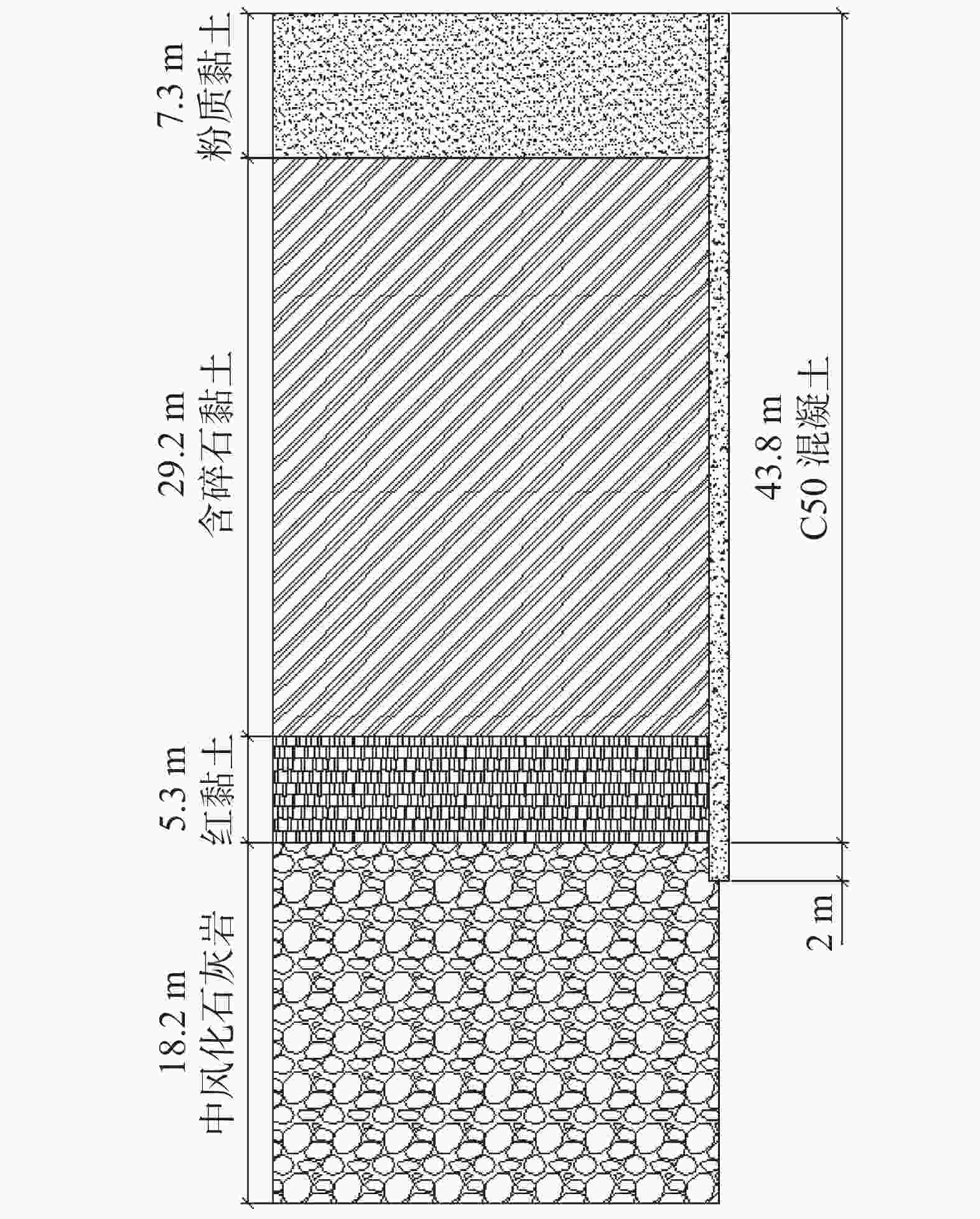
 下载:
下载:
